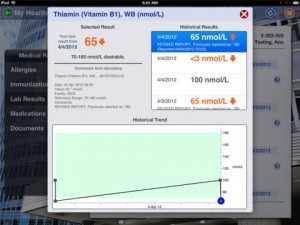
Mayo Clinic's app: Patient
When Stage 2 of the federal electronic health records (EHR) incentive program known as meaningful use begins in October (for hospitals) and in January 2014 (for physicians), compliance for the first time will not be completely in the hands of providers.
Stage 2 rules require participants to give at least half of their patients the ability to view and download their own medical records through online portals or personal health records, up from 10 percent in Stage 1. But more significantly, 5 percent of patients actually have to log in to those portals or healthcare providers will lose out on Medicare and Medicaid bonus payments.
The 5 percent figure may not sound like much, particularly because an earlier proposal called for the threshold to be 10 percent, but it has a lot of providers scrambling. The new requirement, for the first time, makes hospitals, health systems and medical practices to engage patients in their own care or risk losing extra revenue.
"They don't like that it puts the onus on the institution to get patients to use portals," Dr. Bruce Darrow, CMIO at Mount Sinai Hospital in New York City, told MobiHealthNews at this week's Health Information and Management Systems Society (HIMSS) annual conference in New Orleans.
Darrow, a cardiologist, said that his patients are not exactly clamoring for access to their records at the moment. "I am more interested in getting my patient interested in a portal than my patient is in using it," he said. And the interest level dips the lower you go on the socioeconomic scale. "I think it's a much harder conversation to have if you're in East Harlem," Darrow said.
Mobile technology may very well be what breaks down the barriers. "That's going to be where it goes," Darrow predicted. After all, mobile phones – even non-smartphones – often are the only means people have of getting on the Internet.
"Mobile can give access to portals," agreed Kenneth Kleinberg, managing director for healthcare at the Advisory Board Co.
Dr. Kate Christensen, medical director of Kaiser Permanente's Internet Services Group, noted that 4 million Kaiser members have registered to use personal health records through an online portal. In 2012, patients sent 13 million secure e-mails to their doctors' offices, viewed 33 million test results through the portal, booked 3 million appointments and requested 12 million prescription refills.
A year and a half after the organization released its first mobile app, 22 percent of portal traffic comes from mobile devices, Christensen said Sunday during the HIMSS pre-conference physician symposium. And the fastest-growing groups of users are seniors and people with chronic diseases. "The use of smartphones is also skyrocketing among older people," Christensen said, "and I don’t really think it's a barrier until about [age] 85."
According to Dr. Geeta Nayyar, AT&T's CMIO, mobile means "going home with our patients." Obviously, AT&T has a vested interest in continued expansion of mobile communications, but tests have shown that patients like the flexibility.
Last year, AT&T and health insurer Health Care Service Corp. found some success in engaging patients with WellDoc's DiabetesManager. In a pilot among 156 HCSC employees, 88 percent called the system "highly useful" for self-management of diabetes.
"We did the study for six months and found that patients were engaged," Nayyar said at HIMSS.
MobiHealthNews coverage of the HIMSS13 event in New Orleans is sponsored by AirStrip Technologies.














